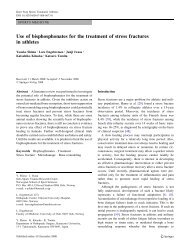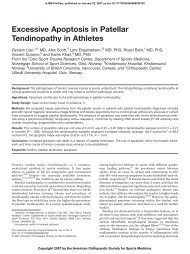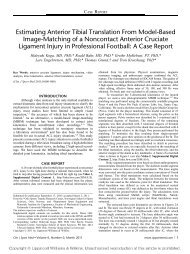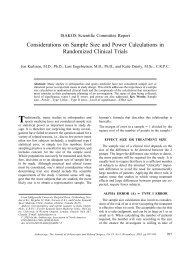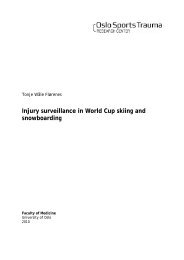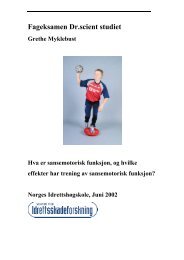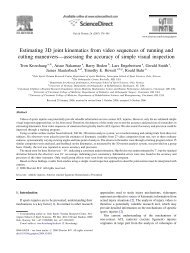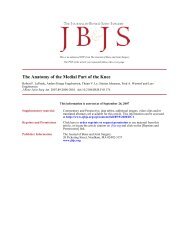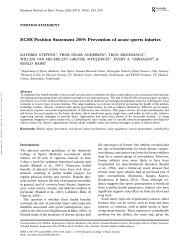Steffen et al.Coping strategies continue to be challenging <strong>factors</strong><strong>as</strong> it seems to be simplistic to analyze them <strong>as</strong>either adaptive or maladaptive (Pensgaard & Duda,2002). In the future, a more fruitful approach mightbe to define coping <strong>as</strong> a positive response outcomeexpectancy (PROE) <strong>as</strong> in the Cognitive ActivationTheory of Stress (CATS), instead of looking atcoping strategies in general (Ursin & Eriksen,2004). High levels of PROE are, e.g. <strong>as</strong>sociatedwith lower levels of work stress and sick leave inthe general population, and even with high per<strong>for</strong>mancein a highly stressful environment such <strong>as</strong> theOlympic Games (Eriksen et al., 2005).Among the young female players, a relationshipbetween ‘‘worry anxiety’’ and previous <strong>injuries</strong> w<strong>as</strong>observed, confirming the results from different prospectivestudies on other types of sport (Blackwell &McCullagh, 1990; Hanson et al., 1992; Petrie, 1993).Among male football players, a lower than averagenumber of previous <strong>injuries</strong> w<strong>as</strong> related to fewerworries about their per<strong>for</strong>mance, less competitiveanxiety and peaking under pressure, a lower angertrait and less outward anger (Junge et al., 2000).However, perceived anxiety be<strong>for</strong>e the start of these<strong>as</strong>on could not predict new <strong>injuries</strong> in our cohort offemale football players.Methodological issuesThis is the first study in female football concerningthe relationship between personality <strong>characteristics</strong>and injury <strong>risk</strong>. One obvious and also general limitationof research in sports psychology is the questionnairesand me<strong>as</strong>urement tools available to <strong>as</strong>sess<strong>characteristics</strong> of interest. Direct comparisons betweenthe present and previous investigations usingdifferent tools should be made with caution. Researchinvolving <strong>psychological</strong> <strong>factors</strong> and injury<strong>risk</strong> in (youth) sports is still limited.A further limitation of the present study w<strong>as</strong> theresponse rate. About 71% of the players completedthe questionnaire, which means that there is a potential<strong>for</strong> a selection bi<strong>as</strong>. For instance, players withprevious <strong>injuries</strong> and symptoms from the lower limbsmay be more likely to respond. However, injuryproportions have been compared between respondersand non-responders, and any difference in the proportionof <strong>injuries</strong> to the ankle, knee, thigh, or groincould be detected (Steffen et al., 2008b).However, compared with most other observationalinvestigations, the sample size is still large. Nevertheless,the observed numerical differences of specific<strong>psychological</strong> <strong>characteristics</strong> were small (o0.5 SD)and reached statistical significance only because ofthe large sample size. Effect sizes (partial Z 2 values)were below 0.03.Another limitation deals with the collection ofexposure data. One theory is that extroverted playersreceive more playing time than introverted playerswho are low in self-esteem, and will there<strong>for</strong>e bemore likely to get injured due to incre<strong>as</strong>ed playingexposure (Kelley, 1990). Here, we were unable torecord individual exposure data, <strong>as</strong> done by, e.g.,O¨ stenberg and Roos (2000), and there<strong>for</strong>e could notcorrect <strong>for</strong> exposure in the <strong>risk</strong> factor analyses.PerspectivesBesides the improvement of physical per<strong>for</strong>mance,technical and tactical skills and injury prevention,personality traits of the players in a team will beessential <strong>for</strong> team success and should be addressed.This study supports earlier investigations by demonstratingthat high life stress h<strong>as</strong> an impact on new<strong>injuries</strong>. In order to attenuate this <strong>risk</strong> factor amongyoung female football players, coaches must beaware of the total life stress situation of the player.A positive motivational climate in a team isconsidered to be favorable to help those playerswith a high perception of life stress (Pensgaard &Roberts, 2000). However, it may be that in certainsituations, a m<strong>as</strong>tery climate can create a strongemph<strong>as</strong>is on individual improvement and development;a coach should avoid and, if present, bufferhigh levels of perfectionism among the players.Coaches will also have the responsibility to lessenlife- and sports-related stress by creating a positivemotivational climate, support improvement in playand playing intensity, concomitant with arranging arealistic ambition level <strong>for</strong> the team to protect theplayers from <strong>injuries</strong> and in the final stage fromburnout (Pensgaard & Roberts, 2002; Lemyreet al., 2008). Implementation of cognitive capabilitiessuch <strong>as</strong> stress-coping strategies may contribute tocreate a balance between <strong>psychological</strong> player <strong>characteristics</strong>and injury <strong>risk</strong> (Johnson et al., 2005).Further observational studies among young and olderplayers are required to extend the present findings.In conclusion, in a cohort of young female footballplayers, a perceived m<strong>as</strong>tery climate and high levelsof experienced life stress could significantly predictthe <strong>risk</strong> <strong>for</strong> new <strong>injuries</strong>.Key words: youth, soccer, psychology, <strong>risk</strong> factor,motivational climate, life stress, coping.AcknowledgementsWe thank the physical therapists involved in the injuryregistration, and the coaches and players <strong>for</strong> their cooperation.This study w<strong>as</strong> supported by a grant from FIFA. Inaddition, financial support came from the Oslo Sports Trauma8
Psychological <strong>risk</strong> <strong>factors</strong> <strong>for</strong> <strong>injuries</strong>Research Center, which h<strong>as</strong> been established at the NorwegianSchool of Sport Sciences through grants from the E<strong>as</strong>ternNorway Regional Health Authority, the Royal NorwegianMinistry of Culture and Church Affaires, the NorwegianOlympic Committee and Confederation of Sports and NorskTipping AS.ReferencesAbrahamsen FE, Roberts GC, PensgaardAM. An examination of the factorialstructure of the Norwegian versionof the sport anxiety scale. ScandJ Med Sci Sports 2006: 16: 358–363.Ames C. Achievement goals, motivationalclimate, and motivational processes.In: Roberts GC, ed. Motivation insport and exercise, 1st edn.Champaign, IL: Human KineticsPublishers, 1992: 161–176.Andersen MB, Williams JM. A model ofstress and athletic injury: predictionand prevention. J Sport Exerc Psychol1988: 10: 294–306.Andersen MB, Williams JM. Athleticinjury, psychosocial <strong>factors</strong> andperceptual changes during stress.J Sports Sci 1999: 17: 735–741.Árn<strong>as</strong>on A, Sigurdsson SB,Gudmundsson A, Holme I,Engebretsen L, Bahr R. Risk <strong>factors</strong><strong>for</strong> <strong>injuries</strong> in football. Am J SportsMed 2004: 32: S5–S16.Askling C, Karlsson J, Thorstensson A.Hamstring injury occurrence in elitesoccer players after prese<strong>as</strong>on strengthtraining with eccentric overload. ScandJ Med Sci Sports 2003: 13: 244–250.Bahr R, Holme I. Risk <strong>factors</strong> <strong>for</strong> sports<strong>injuries</strong> – a methodological approach.Br J Sports Med 2003: 37: 384–392.Blackwell B, McCullagh P. Therelationship of athletic injury to lifestress, competitive anxiety andcoping resources. Athl Train 1990: 25:23–27.Carver CS. You want to me<strong>as</strong>ure copingbut your protocol’s too long: considerthe BRIEF cope. Int J Behav Med1997: 4: 92–100.Cometti G, Maffiuletti NA, Pousson M,Chatard JC, Maffulli N. Isokineticstrength and anaerobic power of elite,subelite and amateur French soccerplayers. Int J Sports Med 2001: 22:45–51.Cowley HR, Ford KD, Myer GD,Kernozek TW, Hewett TE. Differencesin neuromuscular strategies betweenlanding and cutting t<strong>as</strong>ks in femaleb<strong>as</strong>ketball and soccer athletes. J AthlTrain 2006: 41: 67–73.Dunn EC, Smith RE, Smoll FL. Dosport-specific stressors predict athleticinjury? J Sci Med Sport 2001: 4: 283–291.Emery CA, Meeuwisse WH, HartmannSE. Vvaluation of <strong>risk</strong> <strong>factors</strong> <strong>for</strong>injury in Adolescent Soccer:implementation and validation of aninjury surveillance system. Am J SportsMed 2005: 33: 1882–1891.Eriksen HR, Murison R, Pensgaard AM,Ursin H. Cognitive activation theory ofstress (CATS): from fish brains to theOlympics. Psychoneuroendocrinology2005: 30: 933–938.Faude O, Junge A, Kindermann W,Dvorak J. Injuries in female soccerplayers: a prospective study in theGerman national league. Am J SportsMed 2005: 33: 1694–1700.Ford IW, Eklund RC, Gordon S. Anexamination of psychosocial variablesmoderating the relationship betweenlife stress and injury time-loss amongathletes of a high standard. J Sports Sci2000: 18: 301–312.Fuller CW, Ekstrand J, Junge A,Andersen TE, Bahr R, Dvorak J,Hägglund M, McCrory P, MeeuwisseWH. Consensus statement on injurydefinitions and data collectionprocedures in studies of football(soccer) <strong>injuries</strong>. Br J Sports Med 2006:40: 193–201.Gunnoe AJ, Horodyski M, Tennant LK,Murphey M. The effect of life events onincidence of injury in high schoolfootball players. J Athl Trainer 2001:36: 150–155.Hall HK, Kerr AW, Kozub SA, FinnieSB. Motivational antecedents ofobligatory exercise: the influence ofachievement goals andmultidimensional perfectionism.Psychol Sport Exerc 2007: 8: 297–316.Hanson SJ, McCullagh P, Tonymon P.The relationship of personality<strong>characteristics</strong>, life stress, and copingresources to athletic injury. J SportExerc Psychol 1992: 14: 262–272.Ha¨ gglund M, Walde´ n M, Ekstrand J.Previous injury <strong>as</strong> a <strong>risk</strong> factor <strong>for</strong>injury in elite football: a prospectivestudy over two consecutive se<strong>as</strong>ons. BrJ Sports Med 2006: 40: 767–772.Jacobson I, Tegner Y. Injuries amongSwedish female elite football players: aprospective population study. Scand JMed Sci Sports 2007: 17: 84–91.Johnson U, Ekengren J, Andersen MB.Injury prevention in Sweden: helpingsoccer players at <strong>risk</strong>. J Sport ExercPsychol 2005: 27: 32–38.Junge A. The influence of <strong>psychological</strong><strong>factors</strong> on sports <strong>injuries</strong>. Review of theliterature. Am J Sports Med 2000: 28:S10–S15.Junge A, Dvorak J, Ro¨ sch D, Graf-Baumann T, Chomiak J, Peterson L.Psychological and sport-specific<strong>characteristics</strong> of football players. AmJ Sport Med 2000: 28: S22–S28.Kav<strong>as</strong>sanu M. Motivational predictors ofprosocial and antisocial behaviour infootball. J Sports Sci 2006: 24: 575–588.Kelley MJ Jr. Psychological <strong>risk</strong> <strong>factors</strong>and sports <strong>injuries</strong>. J Sports Med PhysFitness 1990: 30: 202–221.Knapik JJ, Bauman CL, Jones BH,Harris JM, Vaughan L. Prese<strong>as</strong>onstrength and flexibility imbalances<strong>as</strong>sociated with athletic <strong>injuries</strong> infemale collegiate athletes. Am J SportsMed 1991: 19: 76–81.Krosshaug T, Slauterbeck JR,Engebretsen L, Bahr R. Biomechanicalanalysis of anterior cruciate ligamentinjury mechanisms: three-dimensionalmotion reconstruction from videosequences. Scand J Med Sci Sports2007: 17: 508–519.Lemyre PN, Hall HK, Roberts GC. Asocial cognitive approach to burnout inelite athletes. Scand J Med Sci Sports2008: 18: 221–234.Lysens RJ, Ostyn MS, Vanden AuweeleY. The accident-prone and overuseproneprofiles of the young athlete. AmJ Sports Med 1989: 17: 612–619.Miller BW, Roberts GC, Ommundsen Y.Effect of motivational climate onsportpersonship among competitiveyouth male and female football players.Scand J Med Sci Sports 2004: 14: 193–202.Murphy DF, Connolly DA, BeynnonBD. Risk <strong>factors</strong> <strong>for</strong> lower extremityinjury: a review of the literature. Br JSports Med 2003: 37: 13–29.Ommundsen Y, Roberts GC, Lemyre PN,Miller BW. Peer relationships inadolescent competitive soccer:<strong>as</strong>sociations to perceived motivationalclimate, achievement goals andperfectionism. J Sports Sci 2005: 23:977–989.O¨ stenberg A, Roos H. Injury <strong>risk</strong> <strong>factors</strong>in female European football. Aprospective study of 123 players duringone se<strong>as</strong>on. Scand J Med Sci Sports2000: 10: 279–285.Pensgaard AM, Duda JL. If we workhard, we can do it – a tale from anOlympic (gold) medalist. J Appl SportPsychol 2002: 14: 219–236.Pensgaard AM, Roberts GC. Therelationship between motivationalclimate, perceived ability and sourcesof stress among elite athletes. J SportsSci 2000: 18: 191–200.9



